What Does a Good Axe Cost?: $25-300 Axes Compared with pics.
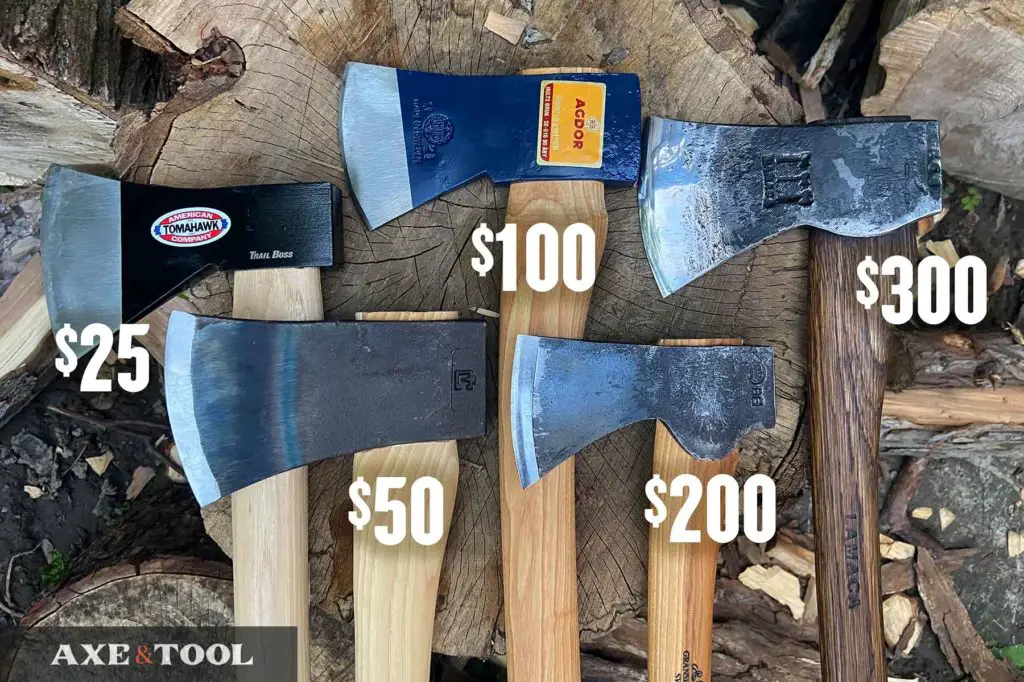
NOTE: With the current state of inflation, some prices may have changed. I will try and keep the article up to date.
When I started buying axes, I was cheap.
But, now I own a lot of axes from $20 to $300, and I’m starting to appreciate the difference between the various price points. And good news – you don’t need to spend $300 for an axe that works well.
A good high-value axe can cost $50-$125. These axes are made with good materials but have a rougher finish level from the factory. A premium axe will be $150-$250 and made with higher-end materials and extra hand fitting and finishing. An artisanal axe will be $200-$500, hand-made, and finely finished.
The average price ranges of axes:
| Hatchet | Midsize | Large | |
| Cheap | $15-$20 | $25-$35 | $40-$50 |
| Good | $35-$60 | $50-$125 | $70-$130 |
| Premium | $120-$170 | $150-$250 | $200-$250 |
| Artisan | $200-$250 | $300-$400 | $400-$500 |
Differences between the price points of axes
While there are unique traits and features between different axe brands, there are some typical features you can expect at a certain price point.
| Sharpness | Steel | Handle | |
| Cheap | Dull or rough | Soft | Fat Varnished Weak |
| Good | Working edge | Medium to high carbon | Thick Shaped Plain finish |
| Premium | Sharp | High carbon | Thinner Shaped Smoother |
| Artisan | Razor-sharp | High carbon | Thin Shaped Smooth |
I will break down the differences in detail below, but I generally recommend axes in the “good” category. They are affordable but can still be put to hard work.
Note: The line tends to blur between “cheap” and “good“, some crap axes can cost more than decent ones. I list some trusted axe brands further on.
Cheap Axes Should be Avoided (Mostly)
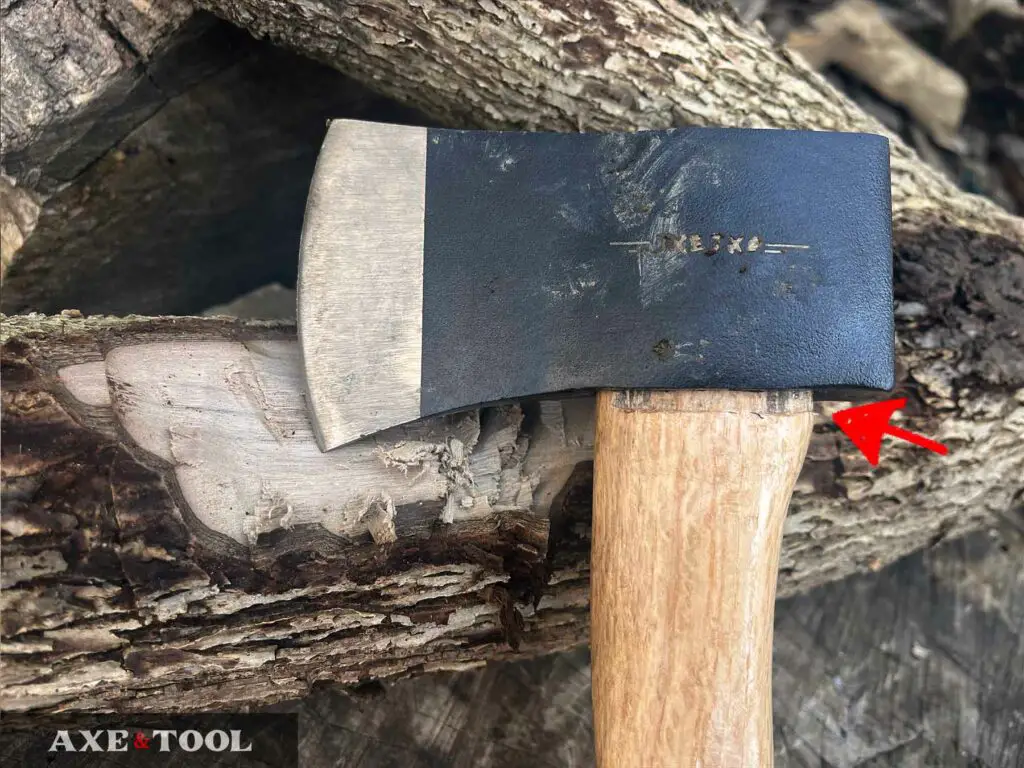
I’ve tried these Amazon and Hardware store axes and they just aren’t worth it. Price isn’t a perfect gauge for quality but If an axe is under $30 (even under $40) it’s just not going to hold up. So just spend the extra $20 and it will make a big difference.
Cheap axes often have a head pattern that looks cool but isn’t practical. They can have shockingly good reviews from people who use them once (or not at all). But if you dig a little deeper you will find rusted heads and broken handles.
Cheap axes use soft steel, so even if an axe starts sharp (it won’t) – you will need to sharpen it frequently to keep it usable.
Wood handles will be fat, covered in varnish, and poorly shaped with no regard for grain orientation. Composite handles can look tough but will be a thick cheap plastic rather than a truly strong composite like the better brands.
Varnish is more likely to cause blisters, and can be bad for the wood. It prevents you from oiling the handle. It must be scraped off or else your handle will dry and crack.
These axes might be fine for a camping trip, or a bit of gardening – but I have also seen more than one break with mild use (like after 2 swings).
Good (high-value) axes are your best choice

Lower-cost axes made by reputable axe makers will perform well as-is, and with a little tuning by the user can often be made as nice in hand as the more expensive options.
I recommend this tier of axe for beginners and those who need a tough working axe. They perform well and are great platforms to learn about technique and maintenance.
There are more full-size working axes in the price range, but you can get all the typical axe sizes. Everything from a 9″ mini hatchet to a 36″ Super Splitter. So you will be able to find a decent affordable axe no matter if you are looking for camping, yard work, bushcraft, felling, or splitting firewood.
I own and have tested axes from all the brands listed below. I have my recommendations further on, but any one of them will be a good option at a reasonable price.
| Brand | Hatchet | Midsize | Large |
| Fiskars | $35 | $60 | $80 |
| Council | $55 | $65 | $80 |
| Estwing | $40 | $65 | – |
| Husqvarna | $55 | $90 | $105 |
| Agdor (Hults Bruk) | $115* | $135 | $140 |
| Hultafors (CAN/UK) | $80 CAN £50.00 | $95 CAN £60.00 | $120 CAN £70.00 |
* The Agdor hatchet is good but kind of pricy
A good axe head will be mid-quality steel. Some are on the softer side (like 1055/1065) but are still much better than the cheap axes. These steels will hold a decent edge but are good to learn to sharpen on because they are a little softer and easier.
The head shapes are effective, but simpler patterns to save on manufacturing costs. They are fitted with a hydraulic press, rather than being hand fitted. This brings the cost down but is more likely to have small gaps or press a ledge into the wood (but will still be functional).
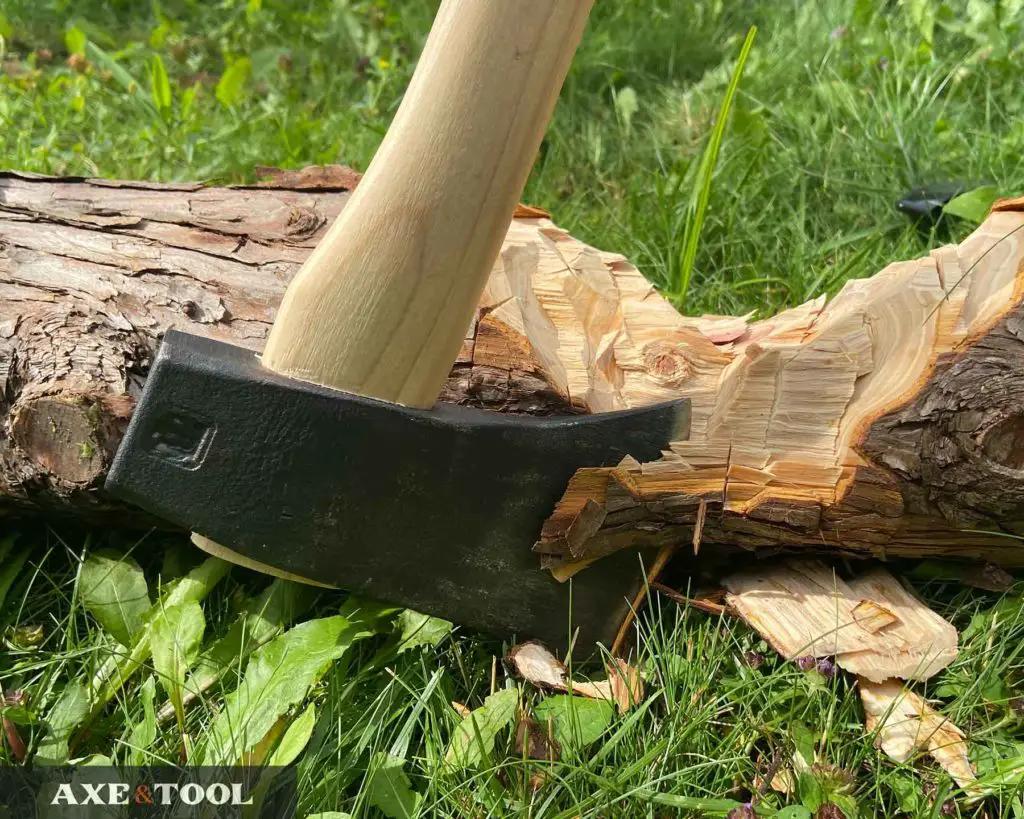
The edge will either be machine-sharped or roughly sharpened to a working edge. Generally sharp enough to chop, but truly sharp. They may be ground a little uneven and tend to have a wider edge angle, which is more durable but less efficient. So a little re-profiling might not hurt.
Wood handles will have an acceptable grain orientation (45 degrees or less), and come oiled (one coat) not varnished – which itself is a massive improvement. The shape of the handle will be okay, but still usually too thick. This is one of the cost-saving techniques – but it’s very easy to thin down the handle yourself.
My recommendations for a good axe
If you are trying to choose an axe I have a more in-depth comparison of good axe brands, but my general recommendations are below.
1. Fiskars makes the best splitting axe for the money. The main splitter is the X27, but they have around 8 models of splitting axe to choose from. We have an article to help you choose the right Fiskars splitting axe if you need it.
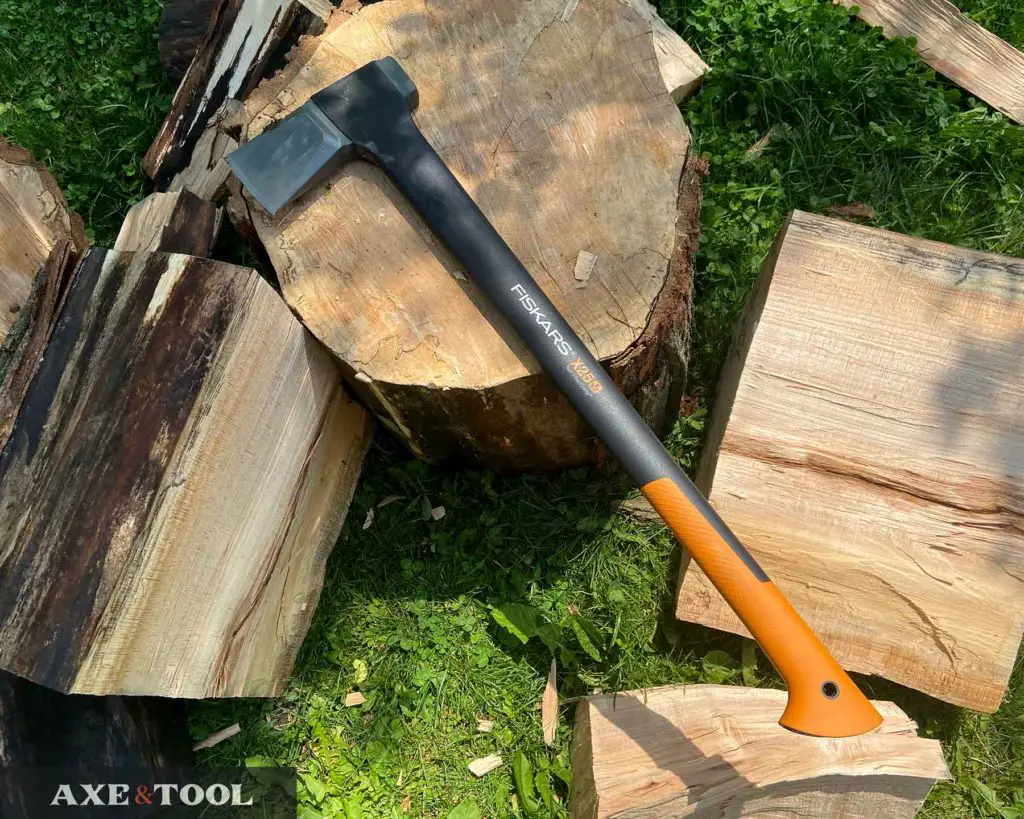
2. Agdor/Hultafors axes are my favorite work axes around the property. The Agdor 28″ Montreal Pattern is my go-to for chopping, but they Yankee pattern is better if you plan to do some splitting too. The handles are fat (on all of them), so plan to thin it down if you get one. Learn how to thin a handle.
3. Council Tool offers amazing value in the USA (where they are made). They make nice American-style axes with decently thin handles and a good edge. The finish can be a little rough, and they don’t come with sheaths, but they can be easily polished up.
The Flying Fox hatchet is a beautiful 16″ hatchet with a hardened poll, perfect for bushcraft.
The Boys Axe is a handy 28″ Dayton pattern, perfect for felling or light splitting.
Premium axes are better, but not for beginners
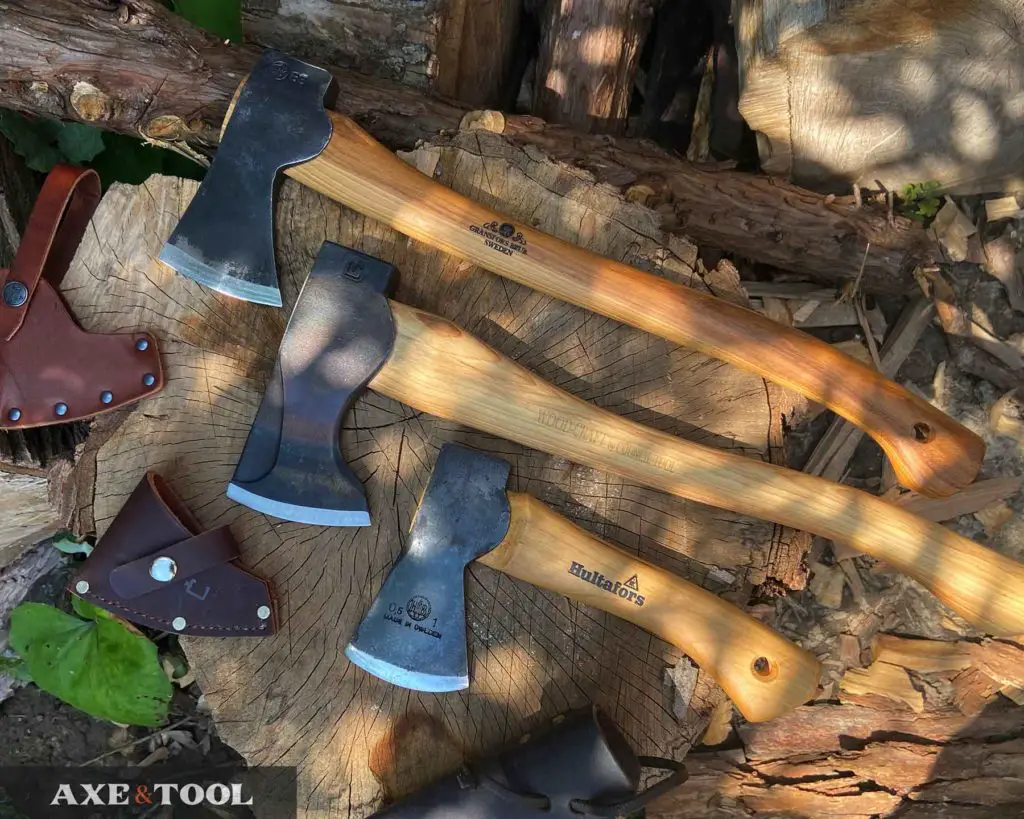
These axes are excellent, but I generally only recommend them if you have axe experience. It’s painful to chip, overstrike, or rust a $200 axe. Trust me, I’ve done it.
it’s important to remember you are paying for longevity, craftsmanship, details, and the finishing touches. Buying a fancy axe isn’t going to improve your technique, or let you cut through a downed tree in half the time. It just doesn’t work that way.
But if you want something special, these are well-finished handmade tools.
| Hatchet | Midsize | Large | |
| Gransfors | $170 | $220 | $250 |
| Hults Bruk | $150 | $180 | $150* |
| Council Tool | $120 | $150 | $200 |
Prices are approximate and in USD
*Hults Bruk large axe is a splitting axe only
The premium heads will be harder high carbon steel that will hold a sharp edge longer, and it will come sharp. They also will have more attention to detail on the shaping and a finer finish. The blade profile will be ground consistently and smooth.
The harder high-carbon steel also makes them harder to sharpen (yes even expensive axes needed to be resharpened), so it’s not ideal to learn on. Again, you don’t want to learn on a $200 axe.
However, the premium axes don’t offer as many size options. Specifically, there are very few larger work axes. Gransfors Bruk offers a 3.3lb American Felling axe, and Council Tool has a 2.25lb Boys axe or 4lb Felling axe. Everything else is 2lb or less, or a specialized design.

The handles will be better shaped, hand-selected, and fit to the heads with more care. Hand-selected handles tend to have tighter better grain patterns, which will be stronger (especially when thinned). Thinner handles are less fatiguing and offer more flexibility.
The sanding will be smoother and the curves and thickness will be more refined than a standard axe, but there is some variation between the brands.
Gransfors Bruk handles come feeling the nicest, as they are oiled and waxed. While the rest are smooth and oiled, they can still sometimes use a bit of extra sanding, oiling, and waxing.
My recommendations for a premium axe
All these axes are great, just keep size/use in mind. Council Tool’s Velvicut line is the best for the larger American-style axes, while the Swedish companies excel in the smaller camp/forest axes.
I would choose either of the Swedish companies over a Council Tool Hudsons Bay pattern, as they are stronger designs.
Splitting axe: Gransfors Bruk large splitting axe or maul is the best shaped (flared like Fiskars), but also the most expensive.Hults Bruk / Hultafors offer splitting axes but I don’t really like the diamond-shaped design compared to the flared options.
Artisan-made axes are perfectly tuned and beautifully made

Lamaca Light Forest Axe on White Oak handle with an Appalachian Black Walnut Finish
Most people do not need an axe in this price range. They are for those who are passionate about axes and craftsmanship but can take up to a year to get your hands on.
There has been a revival in small blacksmith shops forging beautiful handmade axes (in small numbers). They aren’t cheap but you get something special. You will appreciate the attention to detail that goes into every aspect of these tools.
There are more brands out there, but a few notable ones are:
| Hatchet | Midsize | Large | |
| Hoffman | $250 | $350 | $450 |
| Brant & Cochran | $199 | $299 | – |
| Lamaca | – | $329 | $399 |
Prices are approximate and in USD
In my eyes, these axes are both refined tools and works of art. If you are looking at these axes you appreciate the skill and craftsmanship required to make them.
The edges are razor-sharp, the handles are perfectly thinned, the axes come oiled, waxed with exception leather sheaths.
There are makers of both new or hand restored axes scattered around the world. However, they can be hard to get, as numbers are limited and production times vary.
Instagram is a great place to find these makers, especially for restored axes, but here are a few well-known custom axe makers in the US.
Conclusion
I hope this has helped you in your search for a “good” axe. Consider the tasks you will be using it for and balance that with the axe designs and what speaks to you.
Please comment below If I missed something or if you have any questions. I do my best to respond to everyone.
About the author:
About the author:
Jim Bell | Site Creator
I’m just a guy who likes axes. I got tired of only finding crap websites, so I set out to build a better one myself.
I’m also on Instagram: @axeandtool


